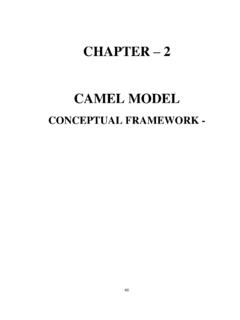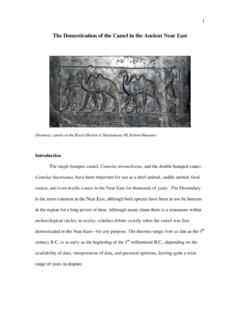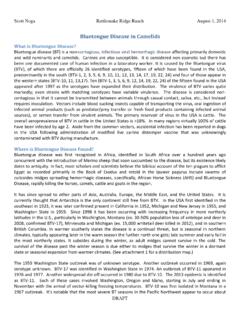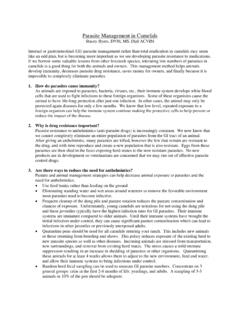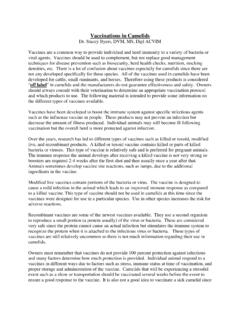Transcription of A CAMELS ANALYSIS OF THE INDIAN BANKING INDUSTRY
1 Electronic copy available at: copy available at: A CAMELS ANALYSIS OF THE INDIAN BANKING INDUSTRY MIHIR DASH1 ANNYESHA DAS INTRODUCTION The BANKING sector occupies a very important place in the country s economy, acting as an intermediary to all industries, ranging from agriculture, construction, textile, manufacturing, and so on. The BANKING sector thus contributes directly to national income and its overall growth. As the BANKING sector has a major impact on the economy as a whole, evaluation, ANALYSIS , and monitoring of its performance is very important.
2 Many methods are employed to analyse BANKING performance. One of the popular methods is the CAMELS framework, developed in the early 1970 s by federal regulators in the USA. The CAMELS rating system is based upon an evaluation of six critical elements of a financial institution s operations: Capital adequacy, Asset quality, Management soundness, Earnings and profitability, Liquidity, and Sensitivity to market risk. Under this bank is required to enhance capital adequacy, strengthen asset quality, improve management, increase earnings, maintain liquidity, and reduce sensitivity to various financial risks.
3 LITERATURE REVIEW The ANALYSIS of BANKING performance has received a great deal of attention in the BANKING literature. A popular framework used by regulators is the CAMELS framework, which uses some financial ratios to help evaluate a bank s performance (Yue, 1992). Several studies involve the use of ratios for banks performance appraisal, including Beaver (1966), Altman (1968), Maishanu (2004), and Mous (2005). Beaver (1966) initiated the use of financial ratios for predicting bankruptcy, considering only one ratio at a time.
4 Altman (1968) went further, using a multiple discriminant ANALYSIS (MDA) for the same purpose, combining several financial ratios in a single prediction model called the Altman s z-score model. However, Altman s model ignored the INDUSTRY -specificity of healthy indications by the financial ratios. Maishanu (2004) studied financial health of banks, and suggested eight financial ratios to diagnose the financial state of a bank. Mous (2005) studied bankruptcy prediction models of banks using financial ratios of profitability, liquidity, leverage, turnover and total assets in decision tree models and multiple discriminant models, and found that the decision tree approach performed better.
5 The CAMEL framework was originally intended to determine when to schedule on-site examination of a bank (Thomson, 1991; Whalen and Thomson, 1988). The five CAMEL factors, viz. Capital adequacy, Asset quality, Management soundness, Earnings and profitability, and Liquidity, indicate the increased likelihood of bank 1 The first author is a senior faculty at Alliance Business School, No. 2 & 3, 2nd Cross, 36th Main, BTM Layout, I Stage, Bangalore-560068, and can be contacted by phone on +91-9945182465, or by email at The other author is a research scholar at the same institution.
6 Electronic copy available at: copy available at: failure when any of these five factors prove inadequate. The choice of the five CAMEL factors is based on the idea that each represents a major element in a bank s financial statements. Several studies provide explanations for choice of CAMEL measures: Lane et al. (1986), Looney et al. (1989), Elliott et al (1991), Eccher et al. (1996), and Thomson (1991). For example, Waldron et al (2006) suggested that one of these threats represented in CAMEL exists in the loss of assets (A); similarly, short-term liquid assets (L) aid in covering loan payment defaults and offset the threat of losses or large withdrawals that might occur.
7 The CAMELS framework extends the CAMEL framework, considering six major aspects of BANKING : Capital adequacy, Asset quality, Management soundness, Earnings and profitability, Liquidity, and Sensitivity to market risk. The usage of the CAMEL(S) framework in BANKING studies in emerging economies is limited. Wirnkar and Tanko (2008) studied BANKING performance of major Nigerian banks using the CAMEL framework. Very recently, Sangmi and Nazir (2010) have studied BANKING performance of two INDIAN banks using the CAMEL framework.
8 Also, Agarwal and Sinha (2010) have studied the performance of microfinance institutions in India using the CAMEL framework. The present study analyses and compares the performance of public and private/foreign banks in India using the CAMELS framework. DATA AND METHODOLOGY The ANALYSIS was performed for a sample of fifty-eight banks operating in India, of which twenty-nine were public sector banks, and twenty-nine were private sector/foreign banks.
9 The study covered the financial years 2003-04, 2004-05, 2005-06, 2006-07, and 2007-08 ( prior to the global financial crisis). The data for the study consisted of financial variables and financial ratios based on the CAMELS framework, obtained from the Capitaline database. The variables used in the ANALYSIS were: Tier-I Capital, Tier-II Capital, and Capital Adequacy Ratio (for Capital Adequacy); Gross Non-performing Assets, Net Non-performing Assets, and Net Non-performing Assets to Total Advances Ratio (for Asset Quality); Total Investments to Total Assets Ratio, Total Advances to Total Deposits Ratio, Sales per Employee, and Profit After Tax per Employee (for Management Soundness).
10 Return on Net Worth, Operating Profit to Average Working Fund Ratio, Profit After Tax to Total Assets Ratio (for Earnings and profitability); Government Securities to Total Investments Ratio and Government Securities to Total Assets Ratio (for Liquidity); and Beta (for Sensitivity to Market Risk). In order to calculate the CAMELS ratings for the banks, the ratios corresponding to each CAMELS factor were considered: viz. Capital Adequacy Ratio, Net Non-performing Assets to Total Advances Ratio, Total Investments to Total Assets Ratio, Total Advances to Total Deposits Ratio, Sales per Employee, Profit After Tax per Employee, Return on Net Worth, Operating Profit to Average Working Fund Ratio, Government Securities to Total Investments Ratio, and Beta (two ratios, viz.)


